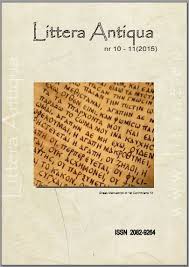The archetype of the jump from a cliff: a ritual linked to orphic and indoeuropean rites for a new reading of Euripides, Suppl., 1012-1014
The archetype of the jump from a cliff: a ritual linked to orphic and indoeuropean rites for a new reading of Euripides, Suppl., 1012-1014
Author(s): Gloria LariniSubject(s): Literary Texts, Cultural history, Ancient World
Published by: Katolicki Uniwersytet Lubelski Jana Pawła II - Instytut Filologii Klasycznej
Summary/Abstract: What have in common the stories of Evadne and Capaneus in the Supplicants of Euripi-des, Sappho and Phaon in the Heroides of Ovid, Bella and Edward in New Moon, the second episode of the recent vampire saga Twilight? The emptiness of love that makes the life un-bearable for a woman that was left alone and a final jump into the water or into the fire. The leap for love seems to have its origin in an archetype of the passion of unpaid love, linked with ancient myths of the death and the Orphic mysteries and rituals. I will try to demonstrate, through a semantic analysis of the monody of Evadne in the Supplicants of Euripides and the letter of Sappho to Phaon of Ovid, that this Indo-European archetype is joined with the Western culture also through ancient Greek and Latin literature; it comes, almost subliminally, as Urtümliches Bild, the primordial archetype of Carl Gustav Jung, to the film New Moon (Twilight saga – 2009), based on the book written by Stephenie Meyer. The images of birds, the water and the moon, the dream, the memory of the lost love, the symbiosis between love and death, the conceptual overlap between death, the carnal un-ion, life and afterlife are elements that help to create a common plot between ancient myth and modern imagery. So it’s possible to explain some uncertain verses (vv. 1012-1014) of the monody of Evadne through a new conjecture, that, in my opinion, can be supported by an Orphic substrate, which concerns the act of jumping into the fire and Orphic image of birds. A quenchless love desire of a physical and spiritual possession, the consequent inability to balance the loss of the lover and the bereavement lead to the jump, voluntary choice and ca-thartic final act of the female part of the couple.
Journal: Littera Antiqua
- Issue Year: 2016
- Issue No: 11
- Page Range: 37-59
- Page Count: 23
- Language: English

